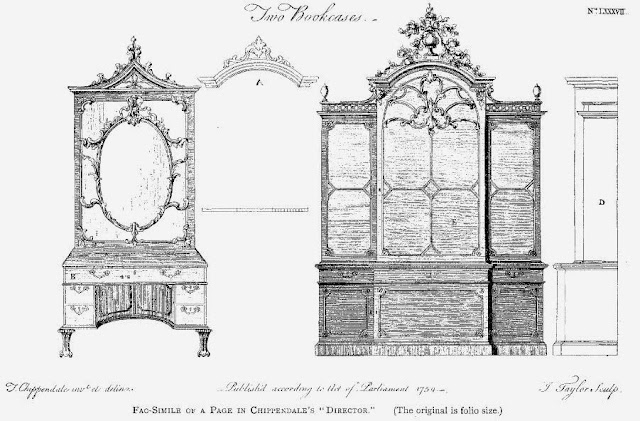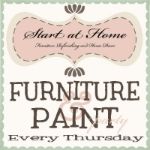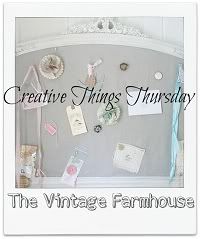This post is partying at:
Tuesday, October 29, 2013
A Vintage Pine Trestle Table
I got this gorgeous vintage pine table from my good friend. It's one of those 1970s pieces, made during the second colonial revival. It had a deep brown stain, which in my experience, is a nightmare to remove. Luckily, when it came to me it had already been sanded, so I didn't need to go through that frustration. I refinished the top in a diluted mixture of pickled oak and English chestnut, giving the table a soft, warm patina. I sealed it in a high gloss for a sleek finish. The base is painted in Navajo white, one of my favorite creamy whites, and then waxed. The table is 6ft x 3ft. Perfect for a new home before the Holidays!
I Built a Farm Table
I've been making pine board tops for dining tables, coffee tables, islands, and sideboards for a few years now, so it was a natural next step to tackle making a whole farm table. This is actually the second one I've built, the first is in my dining room. When I'm at the flea market I keep an eye out for antique table leg sets. They're surprisingly affordable and easy to find, and add the extra character that new legs or straight posts lack. I built the frame in the shaker style and secured it with significant vigor, because there's nothing worse than a shaky table. I added the casters to this one because the legs originally had them, I had an antique set on hand, and the table needed an extra 2" of height to bring it to a comfortable modern dining height (30"). The top is sanded, stained, and sealed pine boards. I painted the base ASCP Old White to contrast with the deep tone of the wood top. I love the grain and rustic feel of them. I beveled the edges to give the top a more finished look. The table is 6feet long and 34" wide. I'm working on a set of chairs that compliment it right now. What do you think?
This post is partying at:
Flea Market Finds
This is that depressing time of year when the weekly flea market gets smaller, and smaller, and finally disappears at the end of November, and then I have to wait, not very patiently, until the end of March for it's glorious return. Luckily, there are still quite a few vendors, and despite the chilly weather, I made some good scores on Sunday morning. I picked up a beautiful aqua wide mouth storage jar that I just love. It has a crack, and so was only $3. I'll put the crack towards the wall and no one will ever know. I also got an adorable vintage egg basket, complete with amusing fake eggs. I snagged a very neglected antique Classical style side table. I worked on it all day yesterday, and you're not going to believe the transformation. Finally, I picked up a fantastic vintage solid pine coffee table set. I also worked on them all day yesterday and they're aaaalmost done.
 |
| I was inspired by the pretty storage jar, so I pulled a bunch of my aqua glass together to do a little vignette by the window. |
 |
| This poor table's been through the ringer, but I loved the lines so much and I have the ideal place for it in my house. Wait till you see what I've done with it! |
 |
| These were just begging to be refinished, and really, those inset faux leather panels were just unacceptable. |
Friday, October 25, 2013
What is Chippendale
What is Queen Anne, so I thought I'd spend a little time today telling you about Chippendale furniture.
In chronological order, Chippendale furniture came after Queen Anne, though there was significant overlap, with both styles being made in the same cabinetmaker shops at the same time, and often being combined in one piece of furniture, so that we would term a piece as Queen Anne or Chippendale based on which period's design elements are most predominantly expressed in said piece of furniture.
Thomas Chippendale (1718-1779), as you might guess from his name, was the father of the Chippendale furniture movement, and arguably had the greatest impact on furniture design of any one person in history. The Chippendale family of Yorkshire had a long lineage in the woodworking and cabinetmaking field. Thomas Chippendale may have started his education under the tutelage of his father, and later completed his apprenticeship with Richard Wood of York. By most accounts, Chippendale was a moderately skilled cabinetmaker, not at the top of his field, but generally well regarded. What he may have lacked in furniture finesse, he made up for with creativity. In 1754 Chippendale published The Gentleman and Cabinetmaker's Director. The publication was ground breaking, the first book of furniture designs ever to be published. Chippendale's immensely creative and whimsical designs incorporated elements of Rococo, Gothic, Chinoiserie, Queen Anne, Mannerist, and Jacobean. As you could imagine, the result was seriously decadent and detailed. Here are a few excerpts from the Director:
 |
| Chippendale Secretary Design source |
 |
| Chippendale Chinoiserie chairs source |
 |
| Chippendale bookcase designs source |
Now as with all design books, the forms pictured within were extreme in style and ornamentation. Cabinetmakers in England, Europe, and North America, who were heavily influenced by the publication, sampled from the Director based on personal preference, level of ability, and stylistic demands of their individual local market. In metropolitan areas like London, New York, and Philadelphia the very best cabinet makers integrated many of the fanciful and decadent elements of floral swags, embellishment, finials, shells, fans, and cartouches. The resulting furniture is remarkably ornate and striking, rendered with the finest materials, imported mahogany, locally sourced cherry and walnut, and bedecked with English brass hardware. In more conservative and rural regions, especially Puritanical New England, Chippendale furniture was more moderate, lacking the garish style of the original designs. The furniture made in these regions is none the less excellent in quality and craftsmanship- and being biased, I would argue that New England Chippendale is the most handsome.
I would be remiss in writing a Chippendale post without mentioning that most recognizable design device, the ball and claw foot. Thomas Chippendale drew inspiration heavily from the natural world, as was typical of all Rococo design of the mid 18th century. The ball and claw foot reached its highest level of perfection in the deft hands of New England's most skilled cabinetmakers, the Townsend family of Newport Rhode Island. The Townsends took the foot a step further by separating each talon from the ball it grasps, a style referred to as "open talon". The level of skill required to complete such a task is staggering. If you ever find an open talon ball and claw foot in the wild, I encourage you to take a good amount of time considering that piece of furniture as true Newport Chippendale furniture is some of the finest, rarest, and therefore most valuable on the antiques market.
Here's a wonderful example of a Chippendale highboy signed by John Townsend and dated 1756. Note the quality of construction, masterful carving of the feet, shell, and finials, and the soft patina. If you follow the link to Sotheby's, you'll see what a highboy of this quality is worth.
 |
| Here's an English 18th century Chippendale bookcase that bears a striking resemblance to Chippendale's original design - see images at top of post. source |
 |
| A beautiful Philadelphia Chest on Chest with ogee feet, scrolled pediment, and ornate floral cartouche. source |
 |
| A wonderful Chippendale lowboy, Philadelphia, with ball and claw feet, carved knees, ornate shaped apron, and carved center drawer. source
In the American Colonies, Chippendale furniture was it it's height from 1760-1800, with each region interpreting the style with delightful individuality that allows the antiques collector to narrow down region of origin with accuracy. By 1790 the opulence of the mid 18th century was becoming passé. Influenced by the American and French revolutions, art, design, culture as whole began the inevitable shift towards simplicity that always follows times of great extravagance. In America, this new trend was called the Federal Period, which we'll cover in another post.
Chippendale form did not disappear from the cabinet maker's vocabulary, however. Forms first introduced in the Director were referenced frequently, reinterpreted in Federal, Classical, and Victorian styles as tastes changed. Chippendale furniture once again shot to the forefront in the early 20th century with the Colonial Revival- with pieces being mass produced in near identical replicas of the original 18th century forms, though lacking the quality that only handmade furniture has. Here's a nice example of a Lane cedar chest in the form of a Philadelphia Chippendale Lowboy- note the similarity to the 18th century piece above.
|
Wednesday, October 23, 2013
Painted Floors
I've decided to paint our upstairs floors. As you may know, we added a second floor to our 1923 bungalow. When we bought the house four years ago it had a full, floored, walk up attic just begging to be claimed as living space. We put in a master bedroom with cathedral ceilings, a guest room, a long hallway, a full bath, and a walk-in closet. The space is finished with the exception of the floors. We did the ceilings in natural pine tongue and groove, with the intention of painting it, but fell in love with the warmth of the wood as it is. I've decided that finishing the pine floors would be too much wood for the space- a little too cabin-y. And I've always loved painted floors. SO the question is what color to paint the floors? I'm leaning toward Benjamin Moore's Lancaster Whitewash at the moment. Included below are a few shots of our floors as they currently look and some painted floors I love. I'm hoping to start the job on Saturday.
Happy Wednesday!
Happy Wednesday!
 |
| The grays and blues look so soft and inviting in this cottage entry way |
 |
| This looks very similar to our hallway upstairs. We even have the exposed brick chimney in the same spot. |
 |
| I love how painted floors reflect light around a room. This cozy sitting room is the perfect example. |
 |
| Having a very neutral palette with pale painted floors and walls really allows for much bolder art work and accessories. |
 |
| I love the warmth this space has, with the antique furnishings and touches of gold here and there. |
 |
| First, marble fireplaces are the best thing ever. Second, the floors are beautiful here. |
 |
| Though there's a lot going on in this space, with a large armoire, striped settee, large windows and folding screens, it all feel unified with the limited colors of cream and white. |
 |
| A stunning bedroom with light painted floors and an eclectic mix of furnishings here. |
 |
| So here's a corner of my bedroom. You can see the floors are the original fir, they're in good condition, though they've seen more than a fair share of paint splatter and the like. |
 |
| And another portion of the master bedroom- here you can see the walls painted in Paradise beach, the color of the pine ceilings, and the current state of the floors. |
Subscribe to:
Posts (Atom)

































